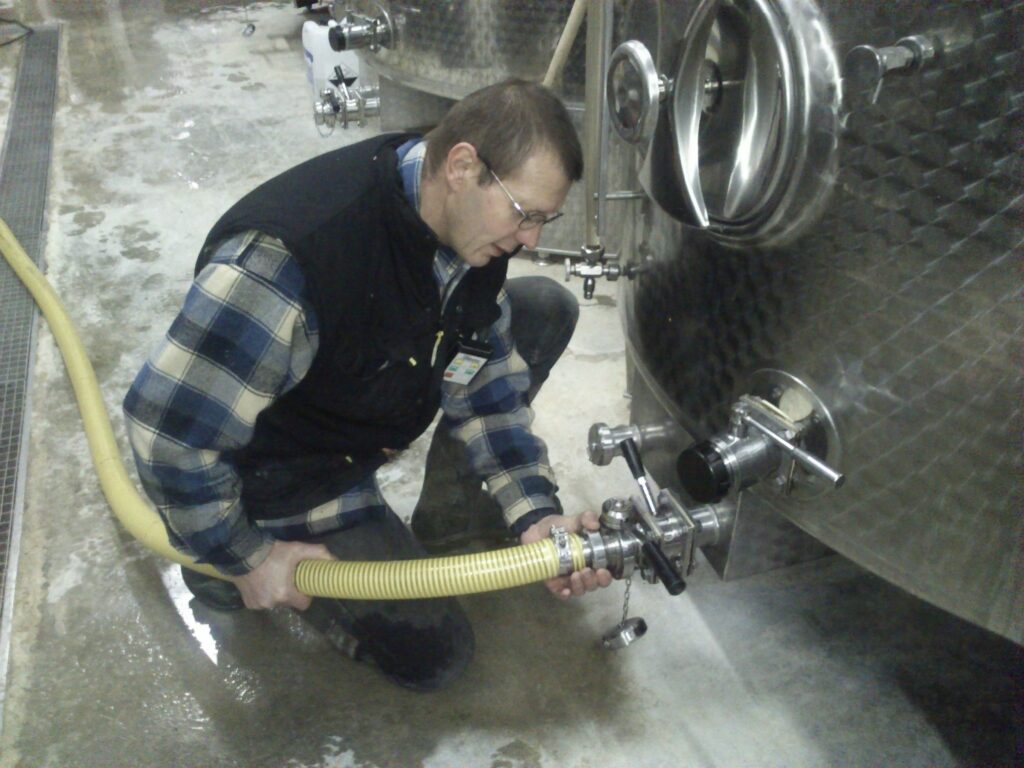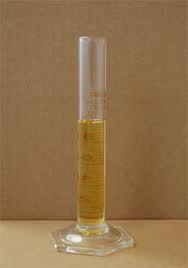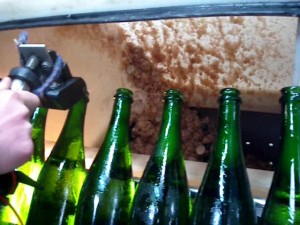Vinification process
Alcoholic Fermentation
Within two weeks after pressing, the sugars in the grape juice will transform into alcohol through a chemical reaction known as alcoholic fermentation. This reaction will produce a large amount of carbon dioxide (CO2). Afterward, the wine will continue to release CO2 while cooling down.

Malolactic Fermentation
Next comes malolactic fermentation. The malic acid in the grape juice, which is a strong acid, will gradually transform into a milder acid, lactic acid. This reaction will produce a little CO2 but mostly allow for the wine to become smoother on the palate and bring out “food” flavors (e.g., cream, fresh butter, milk caramel…).
Racking
Once both fermentations are completed, the wine is left to rest so that all the suspended elements can settle at the bottom of the tank. Racking then involves recovering the clear juice and separating it from the sediment, called the lees.
After one to two weeks of rest, the wines enter their stability phase. We taste them again to analyze their potential and imagine their future.
Blending

Blending is by far the most exciting step for the winemaker: it involves mixing wines from different grape varieties and parcels. We aim to obtain a balanced, aromatic, and consistent blend that characterizes the taste of Champagne Gawron year after year. In doing so, we must envision how the blend will develop with secondary fermentation. In fact, effervescence will amplify the sensations, whether good or bad.
Therefore, it is essential at this stage to work with the purest and most expressive wines possible.
Turning
Next, we will blend the wines on a large scale according to the chosen proportions, taking into consideration minimizing oxygen exposure during the process.
Tangential Filtration
The wine will undergo another filtration to eliminate the last impurities and become perfectly clear. We use the tangential filtration process, which is a biological method that does not require the addition of foreign substances such as cellulose or Kieselguhr earth. The absence of third-party materials also guarantees the perfect preservation of natural aromas.
Packaging
Preparation for bottling
Now, we need to prepare for the bottling of the future Champagne. We add 2.4 kg of cane sugar per hectoliter of wine, active yeast in a proportion of four percent of the volume, and various oenological products.
- Active yeast is composed of yeasts acclimated to wine, which allows for the appearance of foam.
- Oenological products play a role in the riddling of the bottles and in “tartrate” stabilization. Naturally, tartrate deposits form at the bottom of the bottles. We use cellulose gums (or CMC) to agglomerate the tartrate to eliminate it later during disgorgement. This method avoids the cold treatment and brutal filtration of wines, commonly used by other wineries, but which destroy aromas and flavors. These gums derived from wood cellulose are commonly used in the food industry under the name E466 for glazing ice creams, syrups, or beverages.
Bottling
Also known as “racking”, this stage involves transferring the wine into sealed, capped bottles to prevent any leakage.
Secondary Fermentation
Following the bottling stage, we store our wines in a cool and constant temperature cellar (between 10 and 12°C), where the wine undergoes a secondary fermentation process. The active yeast gradually transforms the sugar into alcohol and releases CO2, which progressively incorporates into the liquid. This is how we obtain the unique sparkling character of champagne. Depending on the blend, the process lasts between fifteen and eighteen months. The Chardonnay-based blends require a maturation period of thirty-six months to give their full potential.
Analyses performed on our wines after secondary fermentation reveal a low sulfur dioxide (SO2) content, a molecule usually used to protect wines from oxidation and commonly referred to as “sulfite”. The level is around thirty milligrams per liter, half the average level of other champagnes. We achieve these good results thanks to alternative and more natural processes, impeccable sanitary quality of our harvests, our hygiene precautions, and minimal aeration during the various processes. Sulfite is responsible for headaches and, more generally, the symptoms of a “hangover,” typical of low-quality wines.
Riddling
Once the bottles have reached maturity, they are placed in a “riddle” which will slowly shake and rotate them, neck down, to bring the yeast sediment from the bottom of the bottle to the neck. This process is called riddling, and it helps to clarify the wine and produce a clear, sediment-free final product.
Disgorging and Dosage
At this point, a ” disgorgement liqueur,” composed of old champagne wine and concentrated cane sugar at 600 grams per liter, can be added. At Michel Gawron, we have chosen to add only a small amount of liqueur to preserve the original flavors of traditional champagne. Our “Tradition” blend has a sugar content of approximately six grams per liter, while our “Prestige” and “E” blends have around five grams per liter. Some winemakers choose to add a lot of liqueurs to their champagnes because high sweetness can deceive the taster’s palate and mask faults and defects.
After the sediment has formed, the bottles are taken out of the riddle and positioned neck down, with the tip in a glycol bath at minus twenty-five degrees Celsius. The wine in the neck will freeze, trapping the yeast sediment in an ice cube. All that remains is to uncork the bottle so that the impure ice can be expelled by the pressure and thus released from the bottle (five times higher than atmospheric pressure).
However, we offer a slightly sweeter “Amandine” blend at the request of our customers. This blend is made from the “Tradition” blend wine to which we have added more disgorgement liqueur, resulting in a sugar concentration of twelve grams per liter, which is still much lower than the fifteen grams per liter found in some brut champagnes from other houses.
Corking and Packaging

Following the addition of liqueur, the bottles are fitted with a pure cork stopper and a wire hood. They are then agitated, washed, rinsed, and left to rest for three months to allow the liqueur to fully blend with the wine.
Finally, we proceed to bottle dressing by fitting a capsule on the cork and wire hood and applying our label.
Our champagnes are now ready for tasting, revealing the enchanting magic of their exquisite flavors.


